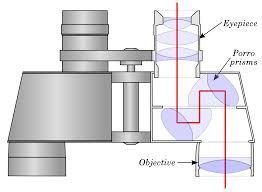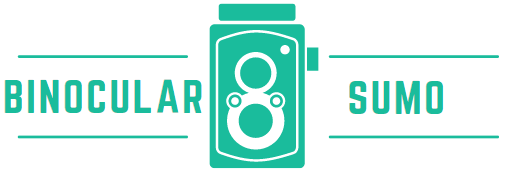
Binoculars are made up of two telescopes, and the telescope is joined side by side in a fixed point that is in the same direction helps the user to view with both eyes to get a single image of an object which is either closer or far away.
Binoculars are of different sizes either they may be small or maybe large according to the use of binoculars. Hands and some not can easily hold some binoculars. Its dimensions vary according to the size of the lens. Binoculars were invented in the 17th century.
If you are confused about the numbers on binoculars, check this guide on What Do The Numbers On Binoculars Mean?
It has developed at the time of galileo and hence from galileo times to modern times the binoculars have evolved. The lenses used in the binoculars can magnify the image, and this process is called magnification. Binoculars are used for various purposes.
It can be handled professionally and also by kids, adults and by every people who are interested in outdoor activities.
The binoculars are uses for whale watching, hikers, astronomers, bird watching, hunting, seeing games, and also the military uses it for different security reasons.
Their pricing varies for use. For general uses, binoculars under $200 work decently.
For decent uses, you might consider increasing the budget. Some people believe that American made binoculars are pretty good than others in the market.
Now we look at the parts of the binocular and short descriptions of it are as given below:
A Quick List Of The Binoculars Parts And Functions
1) Objective Lenses
Objective lenses are made to pick the light and magnify them to the different parts of the binoculars. It is more accurate in getting a clear image. The diameter of the objective lens determines that in which quantity the binoculars can collect the light from the target. Binoculars also contain an eyepiece, which receives the light and hence allows the users to see the object.
Objective lenses also come in various shapes and sizes. The weight of the binoculars gets affected by the different objective lens. The bigger objective lens can collect more light from the object. Nowadays, there are many manufacturers of binoculars, and they use coatings on the lenses to increase light transmission. Surfaces may be multicoated or partially coated.
Whenever coatings increased the optical performance of the binoculars gets increased. We always have to take care of the objective lens that shouldn’t get broken or damaged; otherwise, we will not be able to view the object. The objective lenses play an essential role in displaying the images.
Black Friday is approaching, why not bookmark our binoculars black Friday deals so you won’t miss any offers.
2) Eyepiece Lenses
It also plays a critical role in magnifying the image. These glasses are closed to the viewers’ eyes when you look through your device and are noticeably smaller than the objective lenses.
Whenever the objective lens of binocular gathers the light and bring it on the binoculars to focus the image, first of all, all images are placed on the eyepiece, which then magnifies the images.
Eyepiece comes with different varying focal lengths, which plays an essential role in the magnification of an image. The eyepiece contains various lenses housing. The focus of the image can be focused by moving the eyepiece lenses near to the objective lenses or far away from the actual lenses.
The eyepiece lenses are permanently fixed in the binoculars which provide apparent magnification and a wide range of view. Moreover, hence, it can also be changed. Whenever the field of view is increased or decreased, the magnification also gets increased or decreased.
3) Prism
The objective lens collects some light then forms images after that moves to the eyepiece lens to focus the picture, which is not correct and gets inverted or distorted.
To correct the inverted images into real and virtual images, the lens is placed in between the objective lenses and eyepiece lenses to get a correct image orientation.
The crystal also helps the binoculars to decrease in a smaller size so that it can be held comfortably with our hands and hence becomes more comfortable to handle the binoculars. Mainly two types of prism are used in the binoculars one is roof prism, and the other is Porro prisms.
Roof prism
Firstly the lens which comes in the binoculars to correct the image orientation is known as roof prisms. The roof prism contains various surfaces, and one of the surfaces of the lens denies the total internal reflection, which makes the binocular to lose some light.
To correct the loss of light, the roof prism surfaces should be coated to get representation and also to get sharp images without any loss of view of the pictures.
Porro prism
Another prism that presents in the binoculars is Porro prisms. The Porro prism was invented by Ignazio Porro in mid 19th century Italy.
The surfaces of the Porro prisms are fully multicoated, which makes the surfaces of the lenses shiny and reflective, which results in no loss of light in the binoculars and hence gets a sharp image.
The optical path of Porro prisms is bending like Z structures, which increases the size of a lens, and therefore Porro prism increases the size of the binoculars.
4) Focus Wheel
Generally, the focus wheel of binoculars is placed near the eyepiece lenses, also at the objective lenses, or maybe finds at either one of the lenses. Whenever we focus on the image, the focus comes at the center then it is called the center focus.
Also, if the image gets focused either at right or left, the binoculars are called left or right focused binoculars. The focus wheel functions to move the lenses of the eyepiece and hence, which results in the image focusing clearly.
Mainly the focus wheel helps the eyeglass wearers to target the images without removing the eyeglasses.
5) Diopter Knob
The diopter knob is the ring that is managed to place behind the eyepiece lens. The Diopter knobs can be found either on the objective lens or the eyepiece lens, which can be moved left or right.
It permits you to focus the eyepiece lenses individually. Mainly the diopter knob is introduced in the binoculars to eradicate the strength of eyes for the eyeglass wearers and hence provides eye relief to the eyeglass users.
6) Chassis
Chasis is mainly the whole housing of the binoculars which holds all parts of the binoculars together at one place. All the manufacturers use different types of materials to make the body of the binocular.
Some binoculars are heavy others are durable, and some of the binoculars are lightweight, this all depends on the materials used in the binoculars.
Also, it decides that the binoculars how much can survive in the harsh weather conditions, including the damage.
This content is about the binocular’s parts and functions. Check out our other definitive guides on binoculars.
Best Binoculars For Whale Watching
Vortex Crossfire Vs Diamondback Binoculars
7 Best Binoculars For Police Surveillance | Reviews & Buying Guides
Best German-Made Binoculars Brands | Reviews & Buying Guide
References: https://en.wikipedia.org/wiki/Optics
